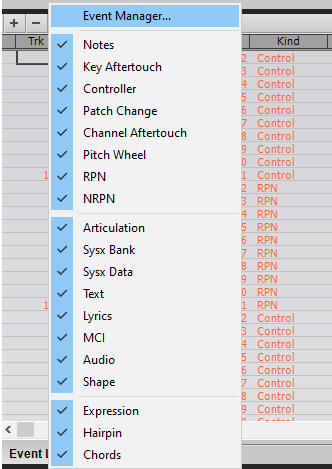-
Posts
6,060 -
Joined
-
Days Won
1
Everything posted by user905133
-
Is that what that button is for!!!!!! LOL. I've had it for decades and had no idea what the image on the button was trying to communicate--totally non-intuitive icon.
-
Neither. See comments from others. 'Nuff said!
-
Yup! Unfortunately, there is no way to tell if the following is what they had in mind or if they were thinking of other "important components . . . that haven't been touched for almost two decades." I just took a guess, but who knows what they had in mind. UPDATE: I just checked the SONAR X1 on my XP PC: (c) 2001-2002. That fits with "almost two decades ago." But again, who knows what they had in mind.
-
Found it (under cons): "Since more than a decade ago no function has been improved." Possibly you misunderstood this phrase. Possibly Slant is not as clear as it could be. As you commented, it is under the "Old Code." To me it seems they are using "function" in a technical sense--as in functions, function calls, routines, etc. in the programming code. Unless you know programming languages, you might not realize this and might read it in a general sense--user features v. computer code functions. I think Slant is saying/trying to say that the computer code used to build the program users install has not yet been rewritten from scratch and uses computer code that hasn't been tweaked/retooled/made more efficient, expanded upon/re-structured, etc. That being said, from all the changes (bug fixes, improvements, new features, etc.) I have seen over the past decade, I cannot imagine the code itself has not been changed. But, I have never tried to reverse engineer the current version and a version from 10 years ago and I have no desire to do so. Nevertheless, it is hard for me to imagine (as a user), that no function [in the code] has been improved over the past decade. I have reported a few issues I experienced and the developers have fixed them. My guess was that changes didn't square with prior code and that the code was changed so as to fix the issues. If you look at the history of changes just over the past year, much has changed in terms of Cakewalk's features and performance. If Slant meant that Cakewalk has been essentially using and building on the UI implemented with SONAR X1 but that many of the parts of the UI are still part of Cakewalk--Track View, Piano Roll View, Console, Browser, Event List, etc. (i.e., it hasn't been revised from the ground up and made to look totally different), that is a different matter. Maybe that's what they meant by the "Old Code" section and they weren't referring to functions in the technical sense. -------------------------------------- Aside: I also think their "Does not respect your freedom" diatribe is misleading and based on a hyper-restricted sense of "freedom" which I suspect comes from a technical, computer programming-activist stance. For an introduction to the complexities of "free as in freedom" mantra, see, for example, this. I might have missed it, but I didn't see sufficient credit given to Cakewalk's extreme flexibility and user customizability. Yes, there is a reference to customizability and the Theme Editor, but for me there is so much more that Cakewalk offers to support users' freedom to create. To take just one example, Cakewalk's Workspaces framework allows users to customize the UI with multiple user presets that are in essence personal workflows. To me that shows respect and dedication to the users' freedom to work in a ways that best meet their needs. There's much more (in my opinion) but I only mention this example here as I believe there is similar potential for misinterpretation. I suspect the "Does not respect your freedom" criticism is based on a highly specialized, computer programming activism stance. Unfortunately, if you don't know about that technical, limited meaning, it is possible to draw erroneous conclusions. I could be wrong. ------------ Apologies to those who just want short, pithy comments and to anyone whose toes I might have stepped on.
-

Motu micro express usb not triggering external sound modules
user905133 replied to Tom Manakis's topic in Cakewalk by BandLab
Based on using parallel port motu midi interfaces (Win 98SE, XP), the sequencer modes do not have routings; instead, routing is done through the DAW/Sequencer. USB versions might be different, but since you don't have routings for the sequencer mode you chose, I'd say its supposed to be that way. I will differ to others with USB versions if they work differently. (Just checked the USB manual and it looks pretty much the same.) As for why you might not have sound in your external gear triggered from midi tracks, as rsinger noted, make sure the correct output port has been selected in Cakewalk. Also, double check the mutings and mappings tabs. -
+1 for Emitt "Recorded At Home" Rhodes. Why? For planting the idea that I can do multi-tracking stuff at home, and for some musical phrases I stole for some jams (e.g. the intro from Fresh as a Daisy, among others). Also, Robert Fripp. Why? Because he also paved the way for doing fun, whacky things. Oh, yeah. Almost forgot Terry Riley. Why? For sonic imagery in "A Rainbow in Curved Air," among others. Not to forget Jimi Hendrix. Why? Because he showed me how to put emotionalism in sounds as sound, for groovy progressions, etc. Yeah--he also took conventions of music and showed how to do new and fun things with the same old same old.
-
In the video the music and the metronome seem to be syncopated. Is that what you meant by latency? If so, does the latency go away if you start the time at the beginning instead of 00:00:15.118?
-
I have seen labelling where MIDI OUT means "connect this to the MIDI OUT of a MIDI device" and MIDI IN means "connect this to the MIDI IN of a MIDI device." I am not familiar with the M-Audio Uno, but I did find a manual online for the M-Audio USB MIDISPORT Uno. It says: “TO MIDI OUT” connector - Connect this plug to your external instrument’s MIDI output port. “TO MIDI IN” connector - Connect this plug to your external instrument’s MIDI input port. This is the opposite of gear that has ports labelled OUT and IN where OUT means "this is where the MIDI data comes out" and IN means "this is where the MIDI data get sent in.
-
Frank Zappa; because he took conventions of "traditional" music and time-honored musical structures / building blocks and showed how to do creative and fun things with them.
-
If you click on the audio dropout toaster message, it should take you to the list of codes. Or you could look it up in the reference guide or online documentation. Wait a sec. Lemme find it for you . . . . Got it!
-

Article: QuadCurve vs. Sonitus EQ - Which Is Better?
user905133 replied to Craig Anderton's topic in Tutorials
Yeah--saw you as one of the Innovative Judges--I mean, one of the Judges for the Innovation Awards. (Enjoyed that live-streamed event!) Glad to see you continue to make a difference! -
Count me out. I don't need to hear things like, "If you want to do notation, get a real notation program," "Use the PRV; its much better," "Real musicians don't use staff notation," etc. over and over in yet another thread. Well, if it gets really heated, maybe I'll use copious ?? and/or ?? signs. ?
-
See above: "I figured out what was happening. I would open a project that had tracks set to a synth I no longer have installed. I would then add Cakewalk TTS-1 as a synth. The tracks would have a bank number that doesn't exist for that synth (like bank "1" instead of bank"15488 Preset Normal 0"). As soon as I change to a proper bank setting, the note names appear." What bank is TTS-1 set to?
-
Not sure this info helps, but I have all normal oohs and ahhs showing up where they should (in the track itself and the plug-in panel).
-
Withdrawn. Post was more of a question related to the capabilities and functioning of the plug-in and only implied a possible limitation that someone considering getting the plug-in might be interested in.
-
Not sure about this specific issue, but there are more recent comments related to work being done for a major revision to integration with Bandlab in this thread.
-
Have you tried support here? I assume that with all the details they have listed there, customer support would know. UPDATE: Evidently the place to ask is in their KVR Forum, not support. Maybe its the CEO who posts and answers questions there?
-
With tinnitus it sounds like vinyl crackle to me.
-
I have never done anything with MPE (Midi Polyphonic Expression), but I thought the MPE Spec enabled gear that supported MPE to map controllers on a note-by-note basis. Pure speculation on my part, but if that's true and you don't have an MPE controller, but the soft synth supports MPE, maybe there's a way to insert the proper midi data to make it happen. Just a guess here.
-
Sounds a little like a cover I heard by The Beach Boys of Hully Gully (originally by the Olympics). (From the YouTube post: This is the record that was copied nearly note-for-note--but with new lyrics--in 1961 by The Marathons (aka The Vibrations) as “Peanut Butter.”)
-
One of the things I like about the Q&A Section is that users can vote for the suggestion(s) they feel is best, is the method they prefer, etc.
-
Did you try what tecknot said? If not, try what Nigel Mackay said.
-
Cakewalk Professional for Windows 2.01 looks like a "collector's item."
-
UPDATE: I cannot get the Event Manager settings to be saved/recalled with Workspaces. Not sure if I have done something wrong, or if they don't get stored because the Event Manager settings are not UI settings. If they are not, it might be nice to have some user definable presets somewhere--in the Event Manager or elsewhere. Also, couldn't save the settings with screensets. So, probably not considered UI savable settings.







